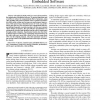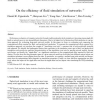ACL
2012
12 years 9 months ago
2012
In this paper we show how to train statistical machine translation systems on reallife tasks using only non-parallel monolingual data from two languages. We present a modificatio...
BMCBI
2010
14 years 4 months ago
2010
TCAD
2002
14 years 6 months ago
2002
The objective of this work is to create a framework for the optimization of embedded software. We present algorithms and a tool flow to reduce the computational effort of programs,...
IJON
2006
14 years 7 months ago
2006
Models of neurons based on iterative maps allows the simulation of big networks of coupled neurons without loss of biophysical properties such as spiking, bursting or tonic bursti...
CN
2006
14 years 7 months ago
2006
Performance evaluation of computer networks through traditional packet-level simulation is becoming increasingly difficult as networks grow in size along different dimensions. Due...
AUTOMATICA
2008
14 years 7 months ago
2008
Abstract-- This paper considers uncertain constrained systems, and develops a method for computing a probabilistic output admissible (POA) set which is a set of initial states prob...
113
click to vote
AMR
2008
Springer
14 years 8 months ago
2008
Springer
Retrieving music from large digital databases is a demanding computational task. The cost for indexing and searching depends not only on the computational effort of measuring music...
HAPTICS
2009
IEEE
14 years 11 months ago
2009
IEEE
Data-driven haptic rendering requires processing of raw recorded signals, which leads to high computational effort for large datasets. To achieve real-time performance, one possib...
EUROGP
1998
Springer
14 years 11 months ago
1998
Springer
Koza has shown how automatically defined functions (ADFs) can reduce computational effort in the GP paradigm. In Koza's ADF, as well as in standard GP, an improvement in a par...
ICRA
2005
IEEE
15 years 24 days ago
2005
IEEE
— The E∗ algorithm is a path planning method capable of dynamic replanning and user-configurable path cost interpolation. It calculates a navigation function as a sampling of ...


